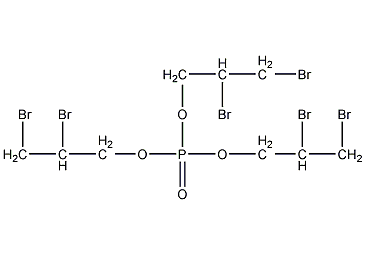Tris(2,3-dibromopropyl) Phosphate


Structural formula
| Business number | 03K7 |
|---|---|
| Molecular formula | (BrCH2CHBrCH2O)3PO |
| Molecular weight | 697.61 |
| label |
2,3-Dibromo-1-propanol phosphate (3:1), Tris(2,3-dibromopropyl)phosphate, 2,3-dibromo-1-propyl phosphate, 2,3-Dibromo-1-propanol phosphate, Tris(2,3-dibromopropanol)phosphate, 2,3-Dibromo-1-propanol phosphate (3:1), 3-(2,3-dibromopropyl)phosphate, phosphate -2,3 – dibromo -1 – propyl, 2,3-Dibromo-1-propanol phosphate, 3 (2,3-dibromo-propanol) phosphate, Additive flame retardant |
Numbering system
CAS number:126-72-7
MDL number:MFCD00039191
EINECS number:204-799-9
RTECS number:UB0350000
BRN number:None
PubChem number:24861005
Physical property data
1. Properties: light yellow transparent viscous liquid
2. Melting point: -3℃-8℃
3. Boiling point: 110℃~130℃
4. Relative density: 2.25
5. Flash point: >112℃
6. Freezing point: -3~-8℃
7. Refractive index: 1.5730 (20℃)
8. Solubility: soluble in ethanol, acetone, benzene, carbon tetrachloride, insoluble in water.
Toxicological data
Rat oral LD50≥75000mg/kg. However, it has different irritating effects on the upper respiratory tract, skin and cornea.
Ecological data
None
Molecular structure data
1. Molar refractive index: 102.12
2. Molar volume (cm3/mol): 300.5
3. Isotonic specific volume (90.2K ): 826.3
4. Surface tension (dyne/cm): 57.1
5. Polarizability (10-24cm3): 40.48
Compute chemical data
1. Reference value for hydrophobic parameter calculation (XlogP): 4.3
2. Number of hydrogen bond donors: 0
3. Number of hydrogen bond acceptors: 4
4. Number of rotatable chemical bonds: 12
5. Number of tautomers: none
6. Topological molecule polar surface area 44.8
7. Number of heavy atoms: 20
8. Surface charge: 0
9. Complexity: 255
10. Number of isotope atoms: 0
11. Determine the number of atomic stereocenters: 0
12. Uncertain number of atomic stereocenters: 3
13. Determine the number of chemical bond stereocenters: 0
14. Number of uncertain chemical bond stereocenters: 0
15. Number of covalent bond units: 1
Properties and stability
Basic properties: The physical and chemical properties of this product are relatively stable.
Soluble in ethanol, acetone, benzene, carbon tetrachloride, insoluble in water. low� It is highly irritating to the upper respiratory tract, skin and cornea. The equipment should be sealed and well ventilated. Operators should wear protective equipment such as glasses and gloves.
Storage method
Store in a cool, ventilated warehouse. Keep away from fire and heat sources. Protect from direct sunlight. Keep container tightly sealed. should be kept away from oxidizer, do not store together. Store and transport according to regulations on toxic and dangerous goods.
Synthesis method
There are mainly two preparation methods in industry: (1) Add propylene alcohol to the reaction kettle, add bromine dropwise at 10-15°C under stirring to perform bromination reaction to generate 2,3-dibromopropanol, and obtain refined 2,3-dibromopropanol by distillation under reduced pressure. Then add 2,3-dibromopropanol to benzene, stir and dissolve, add anhydrous aluminum trichloride catalyst and phosphorus oxychloride, heat to 40°C for reaction, and obtain the crude product. Then it is washed with water, and ammonia is added for neutralization to remove the catalyst and unreacted phosphorus oxychloride. After further washing with water, the finished product can be obtained by distillation under reduced pressure.

(2) Acrylic It is prepared by esterification of alcohol and phosphorus oxychloride and then bromination. 
Purpose
1. This product is a widely used additive flame retardant with a high bromine content, and it also has a certain plasticizing effect. It can be used for flame retardancy of polyvinyl chloride, polystyrene, polyvinyl acetate, soft and rigid polyurethane foam, unsaturated polyester, phenolic resin, acrylic resin, cellulose acetate and other plastics. This product can also be used on synthetic and chemical fibers.
2. Used as an additive flame retardant, with significant flame retardant performance and plasticizing effect. Suitable for phenolic resin, acrylic resin, unsaturated polyester, polystyrene, polyvinyl chloride, polyurethane, cellulose acetate, nitrocellulose, etc. The reference dosage is 2 to 10 servings.